Home
> Scales
/ Lead
> Makes Scales Musical
But there are simple ways to avoid this linear noodling and make scales sound musical, using various types of sequences. Before you start to embellish your scale phrases with techniques such as slides and bends, you need to work on your ability to move around the scale in interesting and musical ways.
Watch the presentation below for an overview of these "sequencing forms" and then scroll down for tabs and more examples...
This may be how we learn the pitch formula of a scale, but when it comes to making music from it, we can arrange that sequence of pitches in many different ways.
Of course, there's nothing wrong with using linear sequential movements, but the more variation you have at your disposal, the broader your improvisational/writing palette will be!
To begin with, we can create exercises that get you used to playing the skipping technique on all strings. In the examples below I'm using a familiar pentatonic pattern (C major or its relative A minor - same pattern). But you can apply these exercises to any scale/pattern you know...
Ex 1.
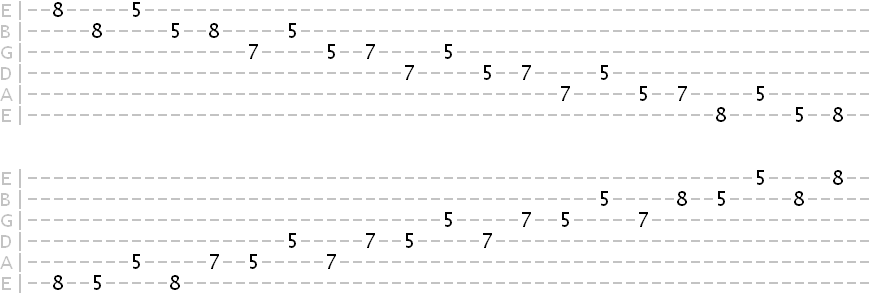
Let's say we wanted to play two consecutive notes on the G and B string. Here's how we would "roll" between them using the index finger...
Let's try some more note skipping sequences (note: to play up the scale simply
start the tab at the end and work backwards!)...
Ex 2.

Ex 3.

Ex 4.
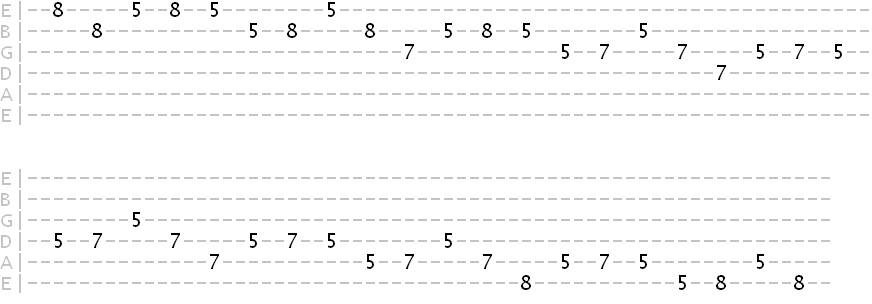
We can also skip two notes in our sequences for more dynamic phrasing. This is more challenging as not only are we skipping notes, we're now skipping strings...
Ex 5.

Ex 6.

And there are probably more. But I'm sure you get the idea! By practicing these non-linear exercises, ideally using a metronome, you'll be able to "borrow" from them, in part or whole, when building your phrases. Mix them with target notes (see the first major pentatonic lesson for more on target notes) and things will start to sound a lot more musical!
Ex 7.

Ex 8.

Remember, the idea is not to necessarily do a full run of the scale every time, rather isolate parts of the sequence and mix them with other phrasing sequences and held target notes.
There are countless possible examples of this, but here are a few (pedal note in red, and for exercise purposes simply repeat at the end of the tab)...
Ex 9.

Ex 10.

Ex 11.

Here's an example, again using A major pentatonic...
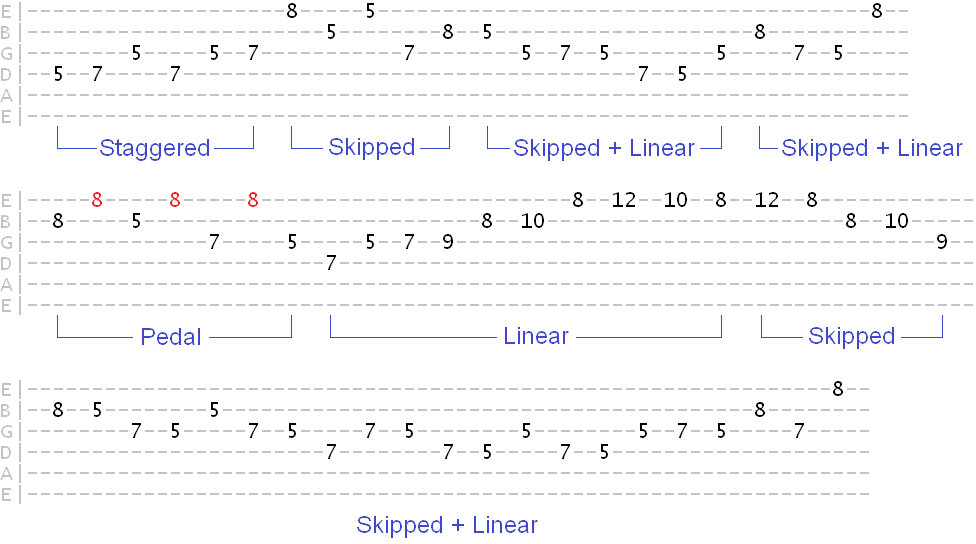
Once you're up to speed with your phrasing ideas, try them over some good backing tracks (I recommend Jonathan Boettcher's Blues or Rock package) so you can practice playing them in a live band context. Your improvisation skills will positively soar this way.
Share your thoughts...
Have any questions, thoughts or ideas about this lesson? Let us know using the comments form below.
How To Make Guitar Scales Sound Musical
Once you learn the roadmap (pattern) for a scale, you'll naturally start looking for different ways to navigate it musically. A lot of guitarists get into the habit of simply playing up and down a scale in a linear sequence. This soon becomes predictable and boring.But there are simple ways to avoid this linear noodling and make scales sound musical, using various types of sequences. Before you start to embellish your scale phrases with techniques such as slides and bends, you need to work on your ability to move around the scale in interesting and musical ways.
Watch the presentation below for an overview of these "sequencing forms" and then scroll down for tabs and more examples...
Turning Scales Into Music
A scale, in its purest form, can be seen as an ordered sequence of pitches/notes - e.g. 1 2 3 4 5 6 7 or C D E F G A B.This may be how we learn the pitch formula of a scale, but when it comes to making music from it, we can arrange that sequence of pitches in many different ways.
Of course, there's nothing wrong with using linear sequential movements, but the more variation you have at your disposal, the broader your improvisational/writing palette will be!
Skipped Note Sequences
By skipping notes in the natural scale sequence, you can instantly create more musical phrases.To begin with, we can create exercises that get you used to playing the skipping technique on all strings. In the examples below I'm using a familiar pentatonic pattern (C major or its relative A minor - same pattern). But you can apply these exercises to any scale/pattern you know...
Ex 1.

The "Rolling" Technique
As mentioned in the video, to keep our fingering economical, we need to use a technique known as rolling in order to play two consecutive notes on the same fret - a common movement you'll have to negotiate when skipping notes.Let's say we wanted to play two consecutive notes on the G and B string. Here's how we would "roll" between them using the index finger...
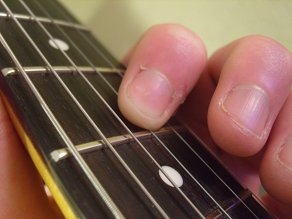 The lower string is fretted using the tip of the finger. |
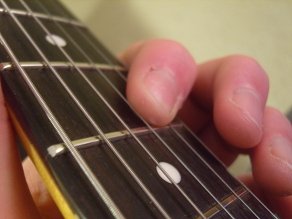 The higher string is fretted using the pad of the finger tip. |
Ex 2.

Ex 3.

Ex 4.

We can also skip two notes in our sequences for more dynamic phrasing. This is more challenging as not only are we skipping notes, we're now skipping strings...
Ex 5.

Ex 6.

And there are probably more. But I'm sure you get the idea! By practicing these non-linear exercises, ideally using a metronome, you'll be able to "borrow" from them, in part or whole, when building your phrases. Mix them with target notes (see the first major pentatonic lesson for more on target notes) and things will start to sound a lot more musical!
"Staggered" Run Sequences
These movements don't involve any skipped notes. Instead we "stagger" the straight run by stepping back a note (or more) every three or more notes in the sequence...Ex 7.

Ex 8.

Remember, the idea is not to necessarily do a full run of the scale every time, rather isolate parts of the sequence and mix them with other phrasing sequences and held target notes.
Pedal Sequences
A great way to make your scales sound musical. Here we pick a static note as our "pedal point" and then alternate between that note and two or more notes around it from the scale.There are countless possible examples of this, but here are a few (pedal note in red, and for exercise purposes simply repeat at the end of the tab)...
Ex 9.

Ex 10.

Ex 11.

Combining Sequences
Once you're confident with these sequencing techniques individually, it's time to practice combining them and build up a solo.Here's an example, again using A major pentatonic...

Once you're up to speed with your phrasing ideas, try them over some good backing tracks (I recommend Jonathan Boettcher's Blues or Rock package) so you can practice playing them in a live band context. Your improvisation skills will positively soar this way.
| Was this
helpful? Please support this site. I really appreciate it! |
Stay updated
and learn more Sign up to the newsletter for updates and grab your free Uncommon Chords book |
Share your thoughts...
Have any questions, thoughts or ideas about this lesson? Let us know using the comments form below.









